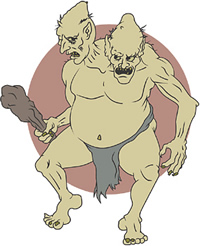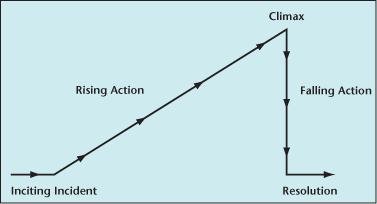Lesson 4.3A: The Modern Short Story
 While stories have been told since people could communicate, the modern short story has really come into its own only since the nineteenth century. Grimm's Fairy Tales (1824), packed with short tales of all things wicked and strange, were one of the first stories to captivate the imagination of their readers - particularily children. The fairy tales were all based on old Germanic stories that had been passed down from generation to generation. Shortly after the Grimm brothers were published, Edgar Allan Poe published Tales of the Grotesque and Arabesque (1836). His stories were completely of his own invention and took the book world by storm. Everyone wanted to read this collection of suspenseful and horrible tales! Poe's stories are now widely recognized as the first of the modern short stories. While stories have been told since people could communicate, the modern short story has really come into its own only since the nineteenth century. Grimm's Fairy Tales (1824), packed with short tales of all things wicked and strange, were one of the first stories to captivate the imagination of their readers - particularily children. The fairy tales were all based on old Germanic stories that had been passed down from generation to generation. Shortly after the Grimm brothers were published, Edgar Allan Poe published Tales of the Grotesque and Arabesque (1836). His stories were completely of his own invention and took the book world by storm. Everyone wanted to read this collection of suspenseful and horrible tales! Poe's stories are now widely recognized as the first of the modern short stories.
In this lesson we will learn about plot structure in short stories and read Poe's "A Tell-Tale Heart."
What Poe Said about Short Stories
Edgar Allan Poe did not just happen to start writing short fiction. He had put quite a bit of thought into what a short story should be. Let's start this lesson by looking at his definition of what a short story is. Because his wording is old-fashioned, each line will be paraphrased in a more modern way.
| Poe said: |
In other words: |
| "A skilful literary artist has constructed a tale." |
A writer has written a short story. |
| "If wise, he has not fashioned his thoughts to accommodate his incidents; but having conceived, with deliberate care, a certain unique or single effect to be wrought out, he then invents such incidents—he then combines such events as may best aid him in establishing this preconceived effect." |
If the writers are smart, they will have a plan for how the plot of their stories will go—they will then combine incidents and events to create the story that they had planned. |
| "If his very initial sentence tends not to the out-bringing of this effect, then he has failed in his first step." |
If the first sentence does not begin to accomplish the planned effect of the story, then the writer has failed from the start to write a good short story. |
| "In the whole composition there should be no word written, of which the tendency, direct or indirect, is not to the one pre-established design." |
All the words of the story should be carefully chosen to achieve the planned plot and effect of the story. |
| "And by such means, with such care and skill, a picture is at length painted which leaves in the mind of him who contemplates it with a kindred art, a sense of the fullest satisfaction." |
By doing this, writers will provide their readers with a full and satisfying read. |
| "The idea of the tale has been presented unblemished, because undisturbed; and this is an end unattainable by the novel." |
The idea or effect of the story will have been achieved without distraction; this is something that cannot be done in a novel (because it is so long and packed with details). |
| "Undue brevity is just as exceptionable here as in the poem; but undue length is yet more to be avoided." |
Making a story too short is not good; however, making a story too long is even worse. |
Simply put, short stories tend to be less complex than novels. Usually, a short story will focus on only one incident, it will have a single plot, a single setting, a limited number of characters, and cover a short period of time.
Most short stories contain the core elements of plot structure:
| exposition |
| |
- the introduction of setting, situation and main characters
|
| inciting action |
| |
- the event of the story that introduces the conflict
|
| rising action |
| |
- the events that occur before the climax
|
| climax |
| |
- the point of highest interest in terms of the conflict, and the point of the story with the most action
|
| falling action |
| |
- the events that occur after the climax, as the central conflict begins to unravel
|
| resolution |
| |
- the point of the story when the conflict is resolved or concludes. The final strings come together or important information about he contlict is revealed
|

Because of their short length, short stories may or may not follow this pattern. Some do not follow patterns at all. For example, modern short stories only occasionally have an exposition. More typical, though, is an abrupt beginning, with the story starting in the middle of the action. As with longer stories, plots of short stories also have a climax or turning-point. However, the endings of many short stories are abrupt and open and may or may not have much falling action or resolution.
 Stop here and read Edgar Allan Poe's "The Tell-Tale Heart" in the pages that follow. While you are reading, use a pencil to underline or circle any words or phrases that you do not understand or that you think are important or interesting. Stop here and read Edgar Allan Poe's "The Tell-Tale Heart" in the pages that follow. While you are reading, use a pencil to underline or circle any words or phrases that you do not understand or that you think are important or interesting.
If you find the story hard to follow, pause every three or four paragraphs to make certain that you have understood what is happening. |
WARNING: there is a scene of a murder described.
Discussion Prompt |
| Some students find Poe's story hard to bear. "It is too gory," they say! Yet other students hardly notice the graphic images of violence. How has your exposure to horrors in film and on the news desensitized your generation? Or, has it? |
Guidelines for contribution:
State your opinion about the topic, and then provide three detailed examples and reasons to support your argument.
Click here to make your contribution now. |

Journal Entry 4.3A: A Tell Tale Secret
Throughout "The Tell-Tale Heart" the narrator insists on being sane, yet at the same time, gives the impression that he is suffering serious hallucinations or paranoia, possibly caused by guilt from having murdered an elderly man.
Think about a time that you have kept a secret - consider how your real-life story might make for a good short story. Now, in your Journal, create a plot sketch (may be fictional or entirely based in truth), and make a list of plot developments as if you were preparing the plan to write your own short story. This writing exercise need not be overwhelming. It is really as simple as making a list of possible things that could happen (or really did happen) in your story of a secret. Consider the example below:
 The Time I Broke a Robin's Egg The Time I Broke a Robin's Egg
- When I was 8-years old, one of my friends showed me a robin's egg.
- She had found it in the springtime because it had been abandoned by the mother bird.
- She told me to not touch it because it was delicate.
- It was so beautiful I could not resist.
- When she went to talk to her Mom I picked it up.
- I can still see the shimmering blue of the shell… before I dropped it on the cement step!
- It stunk!
- The contents were a horror. The little robin that never knew fresh air was rotting!
- I ran away home.
- When my friend called, I told her it wasn't me.
- But the smell didn't lie - the rotten egg odor stayed on my hands for days.
- My mom made me call my friend and confess.
Now sketch out your own secret story!
|
Summary
Completing this lesson has helped you to:
- review the plot structure of short stories
- consider what Edgar Allan Poe said about short stories and how they work
- appreciate one of Poe's most famous short stories
|

